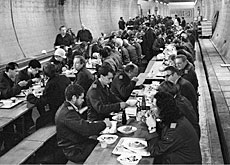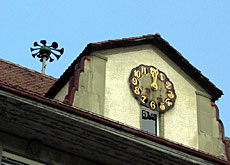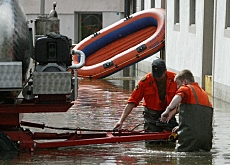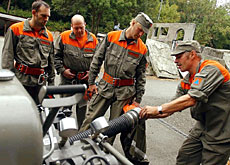Lucerne says goodbye to the Cold War

Operation "Town in the Mountain" has begun in central Switzerland, offering the chance to visit a huge civil protection installation before it is demolished.
The Sonnenberg Tunnel, originally built to offer shelter to 20,000 people in the event of war, is to be turned into a motorway tunnel.
The decision reflects the changed times, in which the civil defence authorities are more concerned with the threat of natural disasters.
The Sonnenberg tunnel in Lucerne is believed to be the largest civilian shelter in the world and was built to hold 10,000 people in each of its tunnels in the event of a conventional, chemical or nuclear attack.
The doors of the tunnel, on the A2 motorway linking the north and south of Europe, are 1.5 metres thick and weigh 350 tonnes. They were designed to withstand the explosion of a one-megaton nuclear bomb within one kilometre of the tunnel.
In a seven-storey cavern in the middle of both tunnels was a command post, an emergency hospital with an operating theatre, a radio studio and various multipurpose rooms.
This would be very impressive if only it worked. When a 1987 dry-run, Operation Ant, tried to find out whether a large proportion of the city could take shelter in the mountain, the doors didn’t shut properly.
This and other shortcomings were never sorted out for financial reasons.
In 2002 the Lucerne authorities decided to disengage the tunnel’s protective rooms and rebuild the existing construction. The cavern will remain in action however as a shelter for 2,000 people.
Problems
Initially, at least, the tunnel seemed to kill several birds with one stone.
In the 1960s the city of Lucerne didn’t have enough civil shelters. The two giant tunnels solved this problem at a stroke – although only a third of the city could squeeze inside.
But thanks to the joint construction of a motorway and a civilian shelter, the federal government subsidised not only the road tunnel but also the SFr40 million ($32.5 million) shelter.
However, the decision-makers at the time clearly overlooked or ignored the logistical and psychological problems created by 20,000 people living cheek by jowl in a tunnel.
“Looking after people is almost impossible on this scale,” Moritz Boschung, head of information at the Civil Protection Office, told swissinfo. “The problems just pile up when you’re dealing with something this size.”
Nowadays the largest shelters hold a maximum of 2,000-3,000 people.
Another factor which played a role in the project’s closure was the much-altered political landscape and reduced threat-levels, as highlighted in the federal security report in 2000.
Following experiences during the Second World War, the shelter constructors gave top priority to suitability and efficiency in the event of war.
“But we ensured that the infrastructure could also stand catastrophes and other emergency situations,” said Boschung. “For example, in 1999 when storms cut the power in an alpine region in southern Switzerland and it wasn’t safe for people to return to their homes, the protection enclosures offered them shelter.”
Tours
The public now have a final chance to visit the Sonnenberg tunnel in Lucerne before it is demolished. During September tours, discussions and other events are taking place.
In addition the Cold War will be reviewed from the perspective of the East and the West, and physicists and chemists will discuss real and imaginary threats posed by new weapons.
But even without the Sonnenberg tunnel, Switzerland still has 270,000 other shelters.
“Modern, artificially aerated shelters are available for 95 per cent of the population,” said Boschung.
Good news, unless you’re in the other five per cent or the doors don’t shut.
swissinfo
In the case of extreme weather or serious earthquakes, the National Alarm Centre sends the alerts of the Swiss Meteorological Office or the Swiss Seismological Service to the affected cantons, the army, the Federal Police Office and other parties.
The alert to the population is communicated by the 7,750 sirens spread across the country and normally operated by the cantonal police.
The population is then supposed to tune in to the radio stations of the Swiss Broadcasting Corporation for information.
Due to Switzerland’s federal system, federal authorities are only supposed to act in a support capacity in the case of a natural disaster.
The Civil Protection Office oversees everything to do with intervention on the ground.
The Federal Office for Water and Geology is responsible for prevention. It houses the secretariat of the extra-parliamentary committee.
To fulfil its prevention brief, the committee brings together public authorities, researchers, insurers and other experts.

In compliance with the JTI standards
More: SWI swissinfo.ch certified by the Journalism Trust Initiative



You can find an overview of ongoing debates with our journalists here. Please join us!
If you want to start a conversation about a topic raised in this article or want to report factual errors, email us at english@swissinfo.ch.